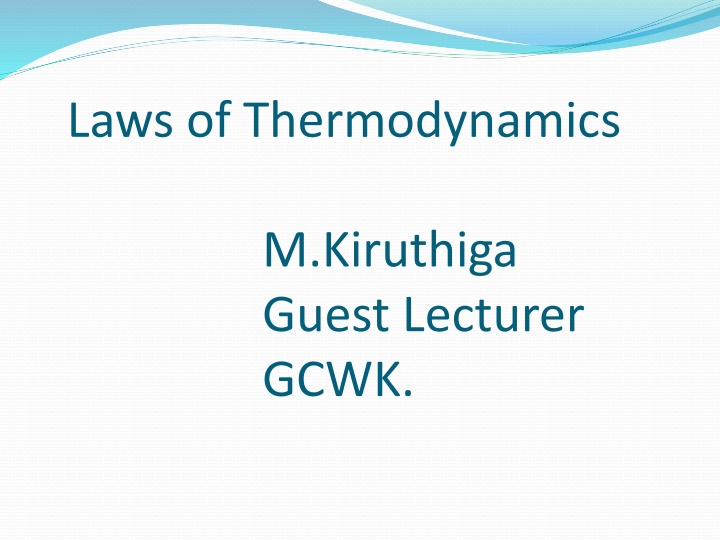
Laws of Thermodynamics and Their Practical Applications
Explore the fundamental Laws of Thermodynamics explained through the 1st Law's energy conservation principle, the 2nd Law's heat flow concept, and the 3rd Law's entropy at absolute zero. Discover how these laws are utilized in everyday technologies like automobile engines, refrigerators, and air conditioners for efficient energy utilization.
Download Presentation

Please find below an Image/Link to download the presentation.
The content on the website is provided AS IS for your information and personal use only. It may not be sold, licensed, or shared on other websites without obtaining consent from the author. If you encounter any issues during the download, it is possible that the publisher has removed the file from their server.
You are allowed to download the files provided on this website for personal or commercial use, subject to the condition that they are used lawfully. All files are the property of their respective owners.
The content on the website is provided AS IS for your information and personal use only. It may not be sold, licensed, or shared on other websites without obtaining consent from the author.
E N D
Presentation Transcript
Laws of Thermodynamics M.Kiruthiga Guest Lecturer GCWK.
1st law of thermodynamics The first law of thermodynamics is an extension ofthe law of conservation of energy The change in internal energy of a system is equal tothe heat added to the system minus the work done by the system U = Q - W If heat added to a system, there are two things that can be done - Change the internal energy of the system, or Cause the system to do work - Combination of the two
2nd Law ofthermodynamics Concept of temperature gradient as a natural phenomenon. The 2nd Law can also be stated that heat flows spontaneously from a hot object to a cold object (spontaneously means without the assistance of external work)
Practical Uses of 2ndLaw Automobile engines, refrigerators, and air conditioners all work on the principles laid out by the 2ndLaw ofThermodynamics
3rd Law ofthermodynamics The entropy of a perfect crystal is zero when the temperature of a the crystal is equal to absolute zero (0 K). At 0 K, there is no thermal motion, and if the crystalis perfect, there will be no disorder Once the temperature begins to rise above 0, the particles begin to move and entropy gradually increases When temperature reaches the melting point of the substance (Tm), there is an abrupt increase in entropy as the substance changes from a solid to a more disordered liquid.
Again the entropy increases gradually as the motion of the particles increases until the temperature reaches the boiling point of the substance (Tb). At this point, there is another drastic increase in entropy as the substance changes from a confinedliquid particles to random motion gas particles. Temperature Entropy relationship
The Zeroth Law This law is concerned with thermal equilibrium. It states equilibrium with a third if two bodies are separately in thermal body then they must be in thermal equilibriumwitheach other If objects A and B are each in thermal equilibrium with object C, then A and B are in thermal equilibrium with eachother






















